Mount Dukono is one of the most active volcanoes in the world, and it’s been erupting non-stop since 1933. If you’re a hiker you can go see this fearsome volcano up close, and needless to say, it’s one of the best hikes in Indonesia!
It’s possible to hike Mount Dukono in one long day, but it’s more popular to spend two days and one night camping on the mountain since it’s less challenging that way and the views are incredible. If you’re feeling brave, you can even climb the crater and peek inside, although there’s obviously danger involved.
Part of the reason this hike is so special is because not many tourists know about it yet. It’s in a remote part of Maluku and it’s more than a little scary, but I’m sure Dukono will be very popular someday. Right now, it’s kind of like Mount Bromo without the crowds!
This travel guide will explain how to get to Mount Dukono, what to expect on the hike, and everything else you need to know before you go!

Apocalyptic views at the Dukono volcano
How To Get To Mount Dukono
Mount Dukono is located on the island of Halmahera, in North Maluku, Indonesia. The closest town to base yourself for the hike is Tobelo, which has hotels, restaurants, and everything else you might need.
To get to Dukono, you can fly to either Kao airport (code: KAZ) or Gamar Malamo airport (code: GLX). Another option is to fly to Ternate airport (code: TTE) and take a boat from there to Halmahera, although it’s a longer journey that way.
There are several direct flights per week to these airports with Wings Air, starting from Manado in North Sulawesi. To get to Manado, there are direct flights from Bali and Jakarta. You can shop for flights in Indonesia on Skyscanner.
From Manado, we flew to the Kao airport, and then it was a 1.5 hour drive to get to Tobelo town, where we stayed the night before and after the hike.

Mount Dukono volcano erupting
Best Local Guide For Mount Dukono
A local guide is essential for navigation and safety at Dukono. Even though it adds expense, I would only recommend doing this hike with a guide.
The path is almost completely unmarked, and it would be very confusing if you try to go alone. A guide will have a better understanding of the volcano’s habits and how close you can safely approach to it on any given day. If you’re staying overnight at the volcano, they can also arrange a porter to carry your camping gear, which will make the hike much more manageable and enjoyable.
I did this trip with Alex Djangu, a local trekking guide who speaks English and lives on Halmahera island. He’s very helpful and knowledgeable about the volcano, and he’s spent many years leading international tourists to Mount Dukono and also Mount Ibu, which is another amazing volcano on Halmahera.
You can contact Alex by WhatsApp at ☎ +62 821-9123-5467 or by email at alex_djangu @ yahoo.com (no spaces). Generally the best way to contact him is by sending a message on WhatsApp.

Drone picture of the Mount Dukono volcano right after sunrise
Mount Dukono Hike: What To Expect
Mount Dukono can be done as a very long and strenuous day hike, or you can camp overnight near the crater and go back down the next day.
The advantage of staying overnight is that you can see the red lava better after dark. You also get to enjoy the unique experience of falling asleep to the sounds of a raging volcano.
I decided to do a 1-day hike at Dukono to save time and money, although I’d love to camp it sometime. Me and Alex started by scooter at 2 AM, driving to the starting point near Mamuya village.
• Jungle Trek
The Dukono volcano has a summit elevation of 1,335 meters (4,380 feet), but you’ll start the hike near sea level.
The first part of the Dukono hike is through jungle, although a lot of it is paved. You’re walking up a steep hill the entire way, but it’s not dangerous in terms of cliffs or exposure.
There are several creek crossings, but they had no water when I was there. Flash flooding may be a problem during heavy rain. For us, the main challenge was trying not to slip on dirt and tree roots.
Along the way, we saw a python, a monitor lizard, some giant centipedes, and several exotic birds. The python was crawling right on the main path, so we had to go around him.

Sunrise in the jungle
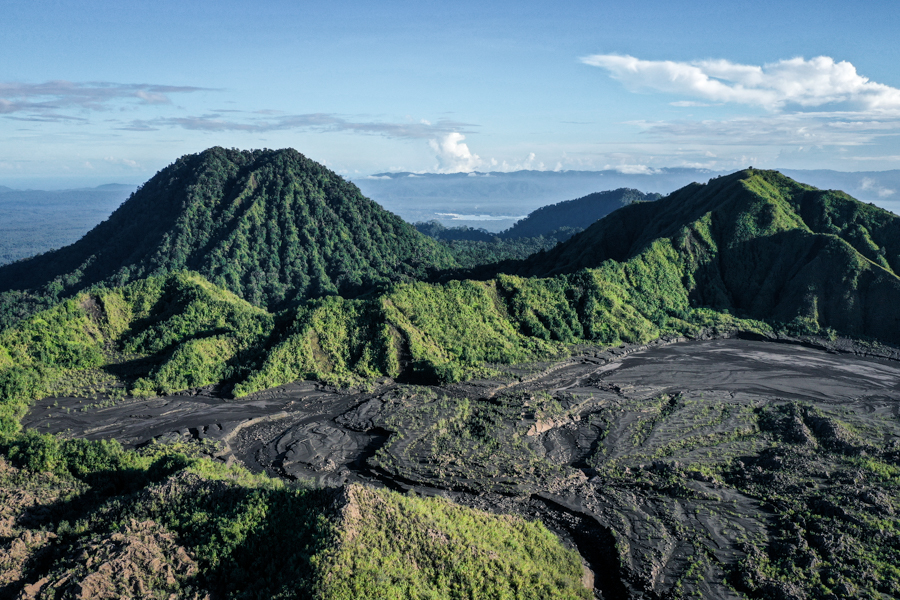
Eventually the jungle ends at an old lava field
• Old Lava Field
After 4 or 5 hours of hiking, we came out of the jungle and got our first views of the smoking crater. We could already hear it rumbling like a jet engine! If you’re camping, this is where you’ll pitch your tent, approximately 1 or 2 kilometers from the volcano crater.
For this next section, you’ll be walking through an old black lava field until you reach the top of the crater. It doesn’t look very far from here, but it takes 1 or 2 hours to get to the top of the crater with a moderate pace. Along the way, you’ll pass an interesting pool of turquoise water.
Walking on the lava rocks can be a bit tricky, but I found it easier than the jungle. We stopped here and I flew the drone a bit, trying to capture the enormous cloud of smoke coming from the volcano.
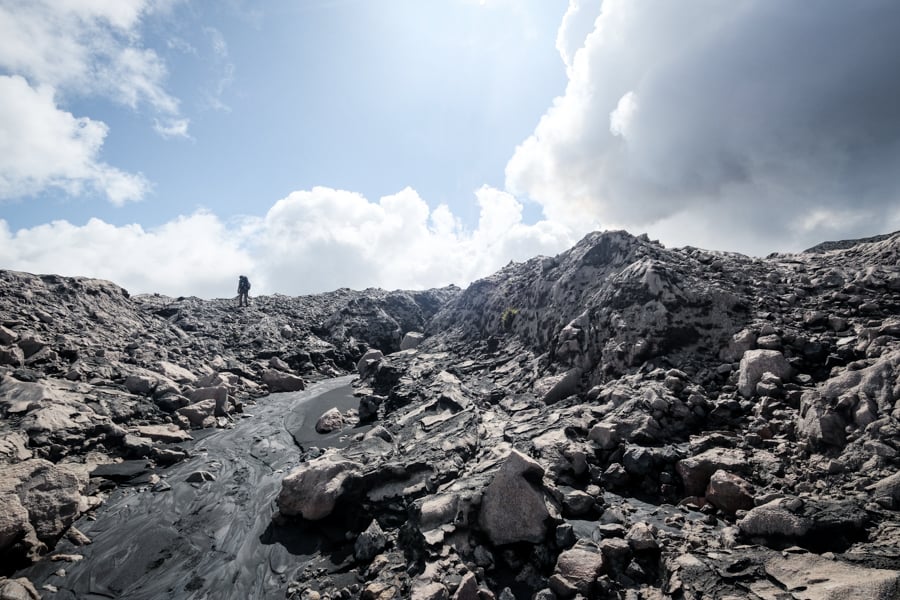
Walking through old lava fields on Mount Dukono
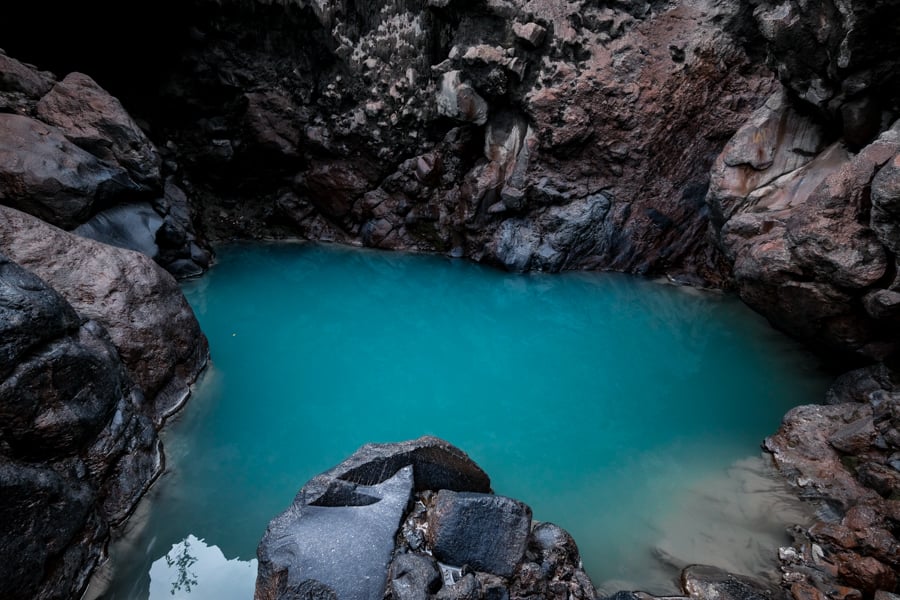
A mysterious blue pool near the volcano
• Dukono Volcano Crater
When we reached the top of the Dukono volcano, we crawled up to the edge of the crater and looked inside while it was blowing out smoke and ash. It’s an awesome sight. Sometimes you can also see red hot molten lava.
For your own safety, don’t go near the crater if it’s shooting out lava rocks. Dukono occasionally spits out giant lava rocks, which land like bombs on the slopes of the crater, and a hit from one of these could be fatal. The volcano thankfully wasn’t shooting rock bombs when we visited, although we saw some recent bombs on the slope of the crater.
We spent about 30 minutes on the crater rim and I flew the drone some more, then we headed back down. The noise, heat, and smoke was terrifying but wonderful at the same time.
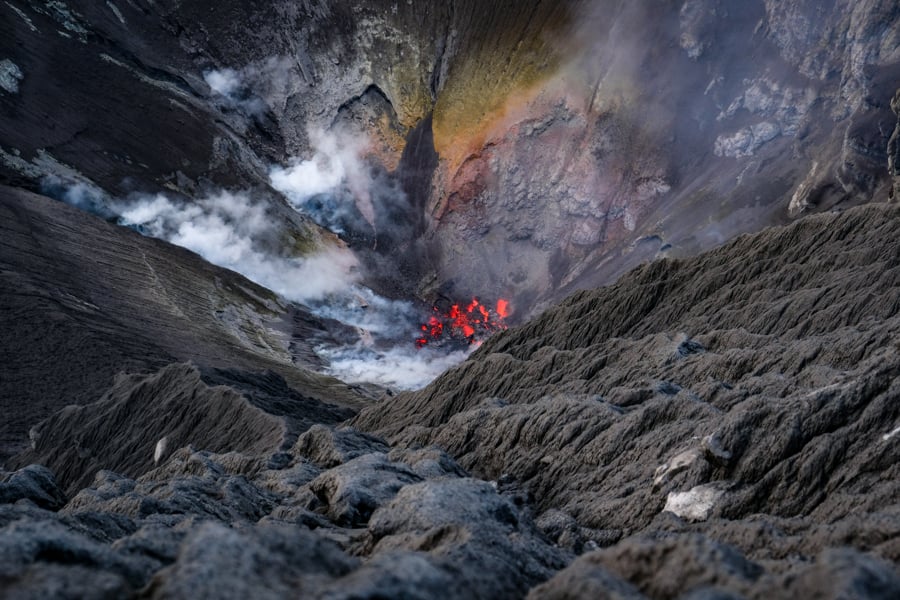
Simmering lava in the crater
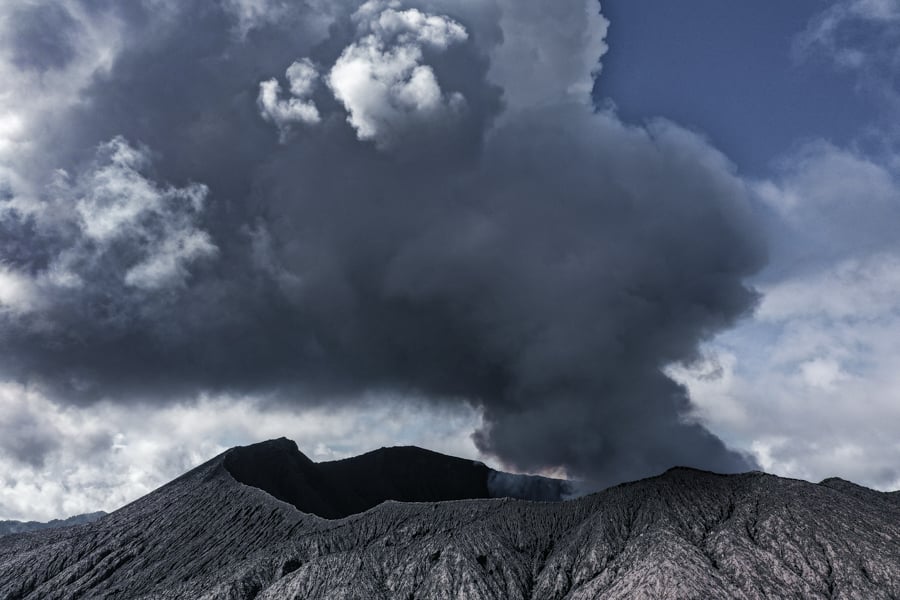
Smoke cloud
• Return Hike
Going back down from Dukono is easier than going up, but it’s still not exactly easy. The paved sections of the path are steep and slippery, especially after rain. We encountered hard rain for 1 or 2 hours on the way down, and fell a bunch of times on the slick pavement.
We started down at about 10 AM, when it was already getting cloudy, and it took us 4 hours to go down from the top of the crater to the start of the trail, or almost 5 hours counting the scooter ride and other things.
In total, me and my guide Alex spent about 12 hours hiking at Dukono, and most of that was an uphill trudge on rough volcanic terrain and slippery mud paths in the jungle. We were extremely dirty and exhausted, especially after starting so early in the night.
I grabbed a quick meal in Tobelo town the following afternoon, and then crashed and slept for something like 11 hours. What a day!
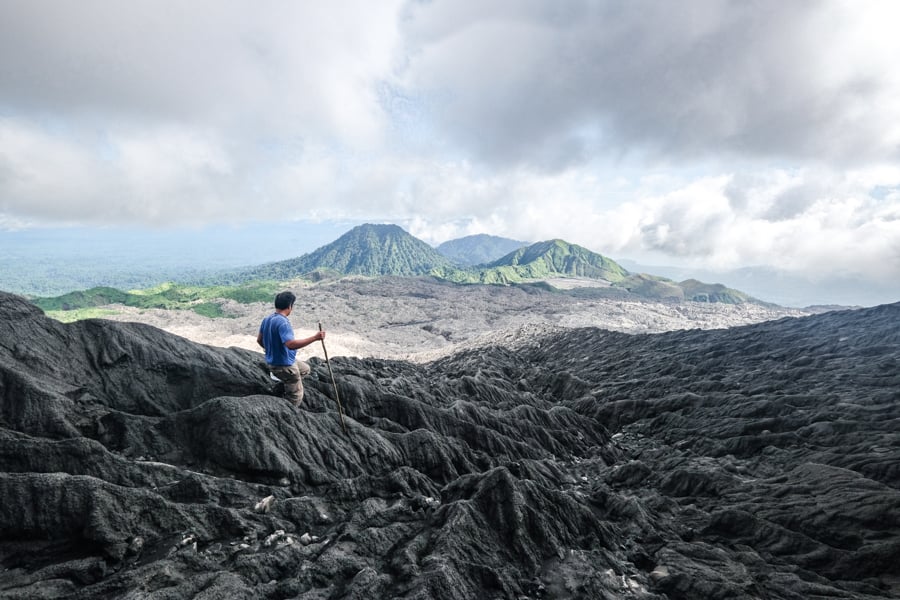
Going back down from the crater
Is Dukono Volcano Still Erupting?
Yes, the Dukono volcano is always active. It’s been erupting non-stop since 1933. If you have specific questions about the current activity, you can contact my local guide Alex at the number mentioned earlier and he’ll be happy to help.
The amount of volcanic activity changes from year to year at Dukono, but it is almost always putting on a good show. When I visited in 2021, there was less ash coming out than normal and it wasn’t throwing many rock bombs.
Is The Dukono Volcano Safe?
Obviously the overall safety of this trek is questionable (at best) because you’re climbing up to the edge of a highly active volcano, but there are ways you can mitigate some of the risk while still having an amazing experience.
The main danger at Dukono is when it’s throwing out rock bombs. These are very big and a hit from one of them could be fatal. The rocks can land anywhere on the slope of the crater at any time. Proceed at your own risk.
If you want to be extra safe, you can just view the volcano from a distance and not peek inside the crater. It’s possible to get some great pictures of Dukono from the old lava field without ever getting in range of the rock bombs, especially if you have a drone.
Rarely, there are some more severe eruptions at Dukono. This happened in 1550, causing death and destruction on Halmahera island, and other major eruptions were recorded in 1719, 1868, and 1901. You can check for status updates on Magma Indonesia before you go.
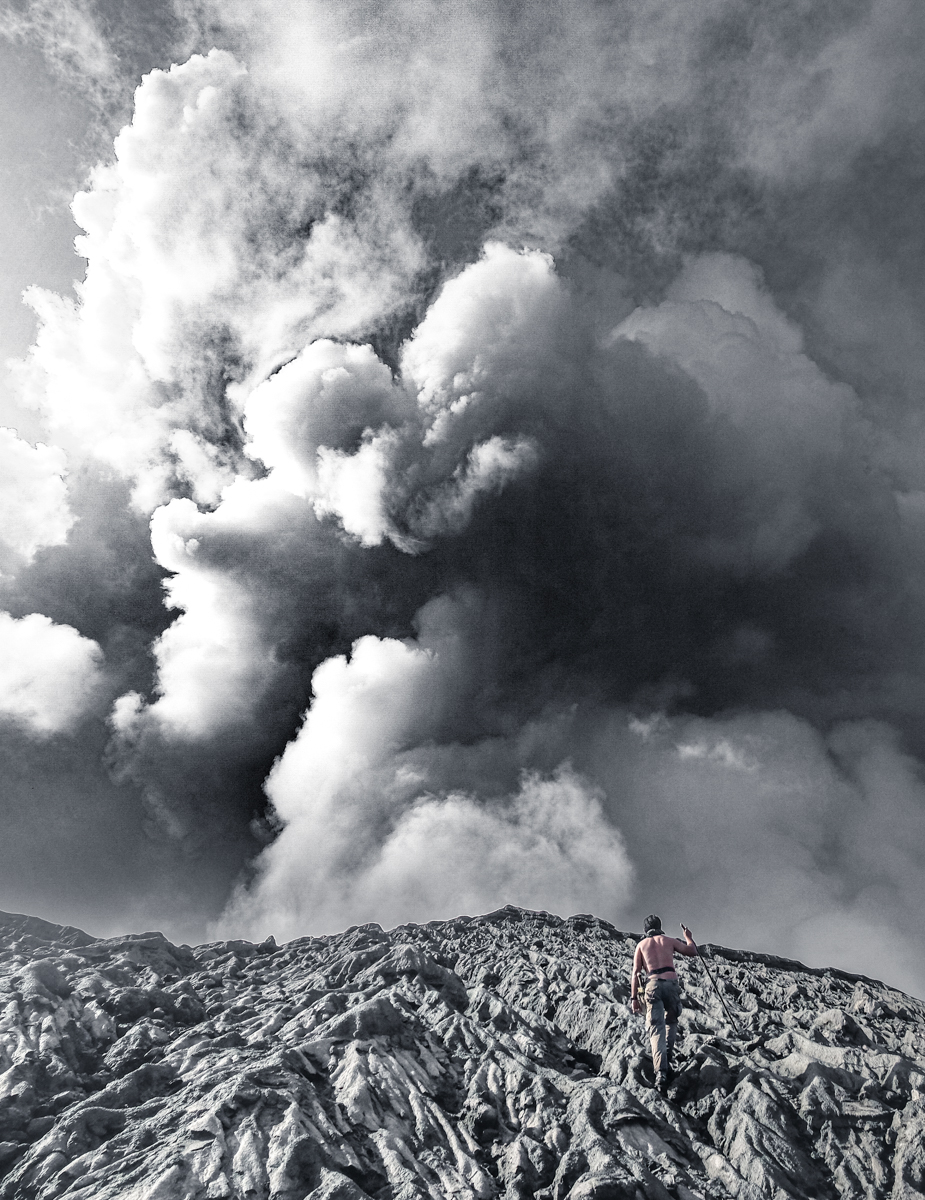
Epic!
When To Hike Mount Dukono
If you’re doing Mount Dukono as a 1 day hike, then you’ll need to start very early, around 2 AM or so. This is because it’s a very long hike and ideally you want to be at the crater shortly after sunrise when the sky is clear and you can see the eruptions without clouds.
If you’re doing Dukono as a 2 day hike, then the timing is more flexible. Even if it’s cloudy or raining when you first get there, it should be clear at night and/or the following morning.
The climate in Tobelo is fairly rainy all year long. The driest months are July to October, and these months are definitely ideal for hiking, but I wouldn’t be too afraid to go to Dukono outside of these months.
We went to Dukono in June, and we did get caught in a downpour for 1 or 2 hours in the afternoon as we were heading back down through the jungle, but it didn’t spoil our hike at all or keep me from taking lots of pictures at the volcano.
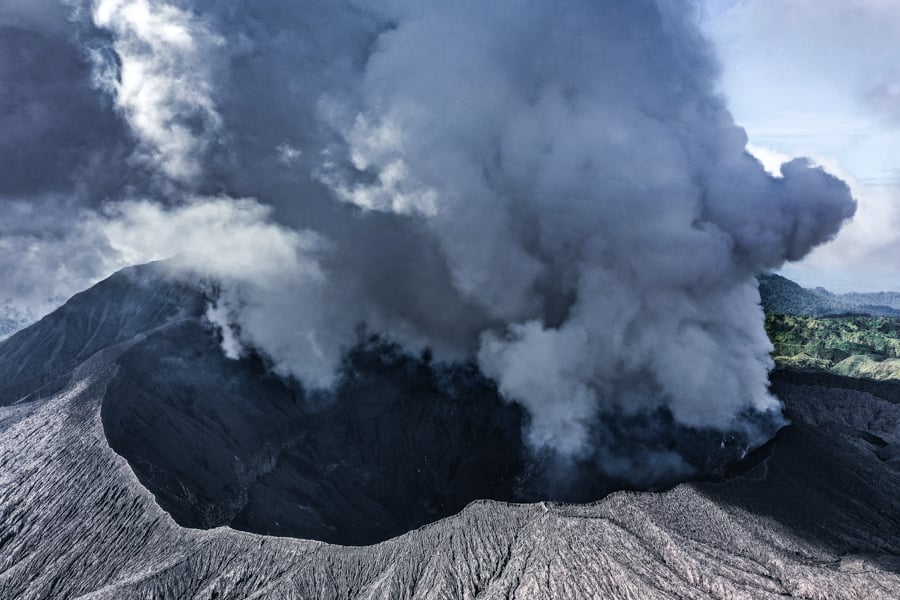
Another drone picture of the fuming Dukono volcano
What To Bring
- Footwear. Real hiking shoes or boots are a must. The path at different times can be rocky, muddy, or very slippery. Even the paved sections can be slick if you don’t have good traction.
- Headlamp. A headlight and spare batteries are essential because of how long the hike is. You’ll probably be starting or ending the Dukono hike in the dark, so you need to be able to see where you’re walking.
- Raincoat. It’s common to run into at least some rain during the trek, so it’s a good idea to bring a small foldable poncho, especially if you have electronics you need to keep dry.
More Tips For Halmahera Island
- Cell Service. We had good 4G reception with Telkomsel on the island, but WiFi is still rare.
- Electricity. There was stable 24/7 electricity in Tobelo town in our experience.
- Mosquitoes. We only encountered some mosquitoes near the start of the hike, and at our hotel in Tobelo town. Once we got to the old lava field and near the volcano, we never saw any mosquitoes. Overall, there weren’t a lot of mosquitoes on this hike, although your experience may vary.
- Malaria. There may be some presence of Malaria in North Maluku, but it’s definitely diminished according to this Lancet study from 2018. We were very careful to use bug spray and avoid mosquito bites, but we didn’t take malaria prophylactics.
- Roads. The roads in and between towns were in good condition. The scooter road to the start of the hike was not great, but not terrible either. This could change depending on weather.
- ATM. There are working ATMs in the area. They all seem to give 50k Rupiah notes.
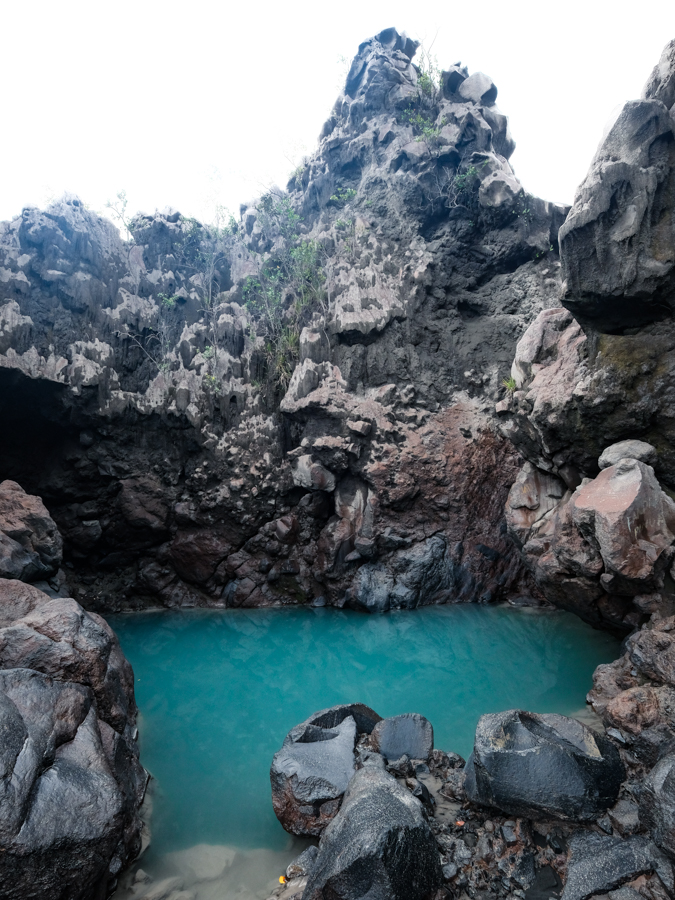
Blue pool
Indonesia Drone Video
Here is a YouTube video with some of my drone shots of Mount Dukono and other Indonesian volcanoes, waterfalls, and natural sights.
This video was filmed across Bali, Java, Maluku, Sulawesi, Sumatra, and other islands in Indonesia.
More Indonesia Travel Guides
Thanks for looking! I hope you enjoyed this travel guide for the Mount Dukono volcano hike in Maluku, Indonesia.
Don’t forget to check out my Indonesia Travel Guide and my list of the best hikes in Indonesia!
See Also
- Most Beautiful Indonesian Islands - Best Places To Visit In Indonesia
- Best Hikes In Indonesia - Volcanoes, Jungles, & Waterfalls
- Indonesia Waterfall Guide - Best Waterfalls In Indonesia
- Indonesia Beach Guide - Best Beaches In Indonesia
- Best Things To Do In Indonesia - What To Do In The Islands
- Indonesia Travel Guide - Tips, Info, & Photos